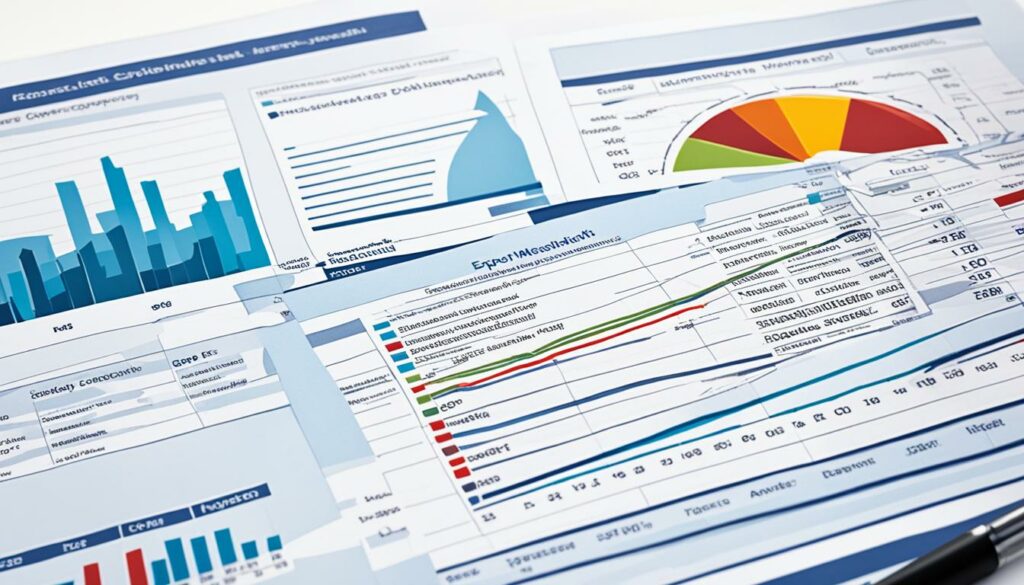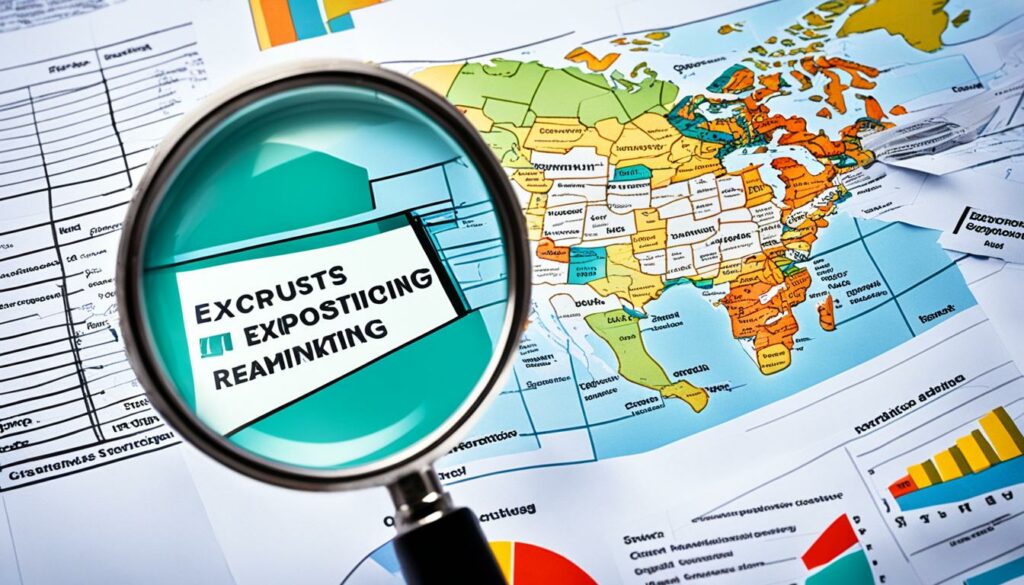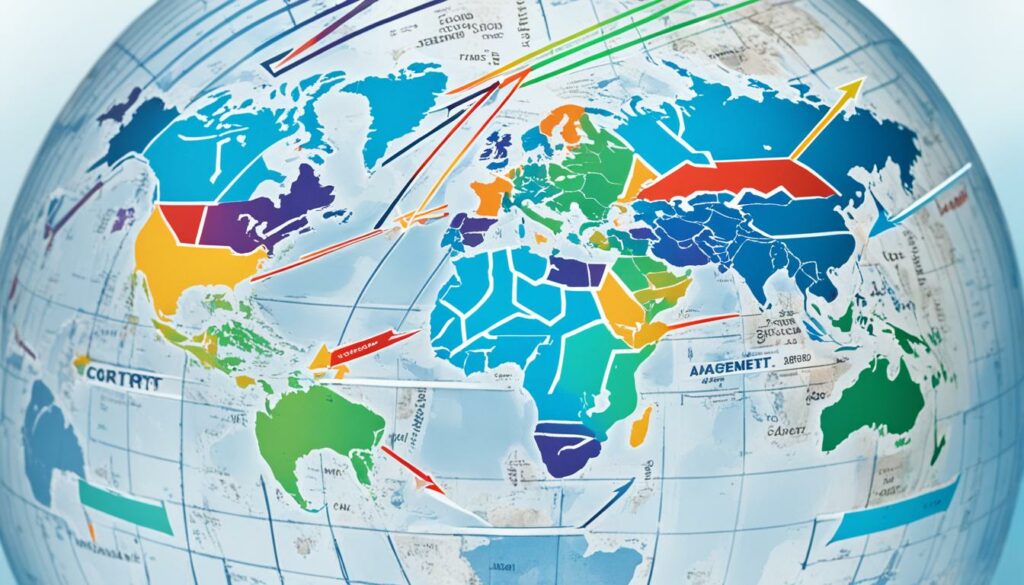Menu

Focusing on 3 to 5 potential markets is smart for small companies. It shows the importance of doing detailed market research before going international. This research helps in finding the best places to export to, considering the market’s size, demand, and competition.
Gathering data from various sources is key to success. Online resources and trade data make this task easier. They help businesses target markets that promise growth, are large, or are quickly developing but face less rivalry. This way, companies can meet customer needs in foreign lands.
Doing detailed export market research is key for any business that wants to succeed globally. It’s essential to know market dynamics, find export chances, and lower risks. This detailed work boosts decision-making, giving firms deep insight and full trade research.
Knowing market dynamics helps spot opportunities by looking at demand, competition, and trends. It lets businesses adjust their products to meet market needs.
| Research Type | Benefits | Examples |
|---|---|---|
| Primary Market Research | Direct information from foreign markets | Interviews, Surveys |
| Secondary Market Research | Cost-effective, using existing reports | Trade Statistics, Market Reports |
Finding growing export areas is crucial. By using market trends, smaller companies can pick 3-5 promising markets, aiding smart investment decisions.
To reduce risks, businesses must take proactive steps. They should look at a country’s political and economic stability, and its laws. This helps in identifying and handling challenges.
An export plan based on strong market intelligence can help businesses succeed in global trading. It leads to lasting growth and presence in the global market.
Making clear research questions is key for good export market research. It help you look for important market insights and trends in a structured way. We’ll look at what to keep in mind when asking these questions.
For new exporters, start with questions that focus on your target markets. You should aim to know:
These questions help you figure out if your product can sell well in the market. And also, help you plan for any shipping or other challenges.

It’s important to figure out the market size and demand. This part of research includes questions like:
Asking these questions helps you guess how much you could sell and if the market is stable long term.
Knowing who you’re up against is crucial. You should ask questions like:
Doing a thorough competitor analysis lets you see how to make your product stand out. This helps you figure out your unique selling points and where you can outshine the competition.
When you put all these parts together in your export market research, you get a full picture. This leads to smart and well thought out decisions for your export plans.
In the realm of market research strategy, primary market research is key. It helps gather detailed info from the target market directly. This enables companies to meet specific needs and stand out from competitors.
Surveys and interviews are basic for getting important data from potential customers. Businesses use these to learn about preferences, prices, and what features matter most. Well-done surveys spot trends. Interviews give in-depth views, essential for understanding consumer behaviour.
Trade shows and conferences are crucial for meeting experts and buyers. They let you check out rivals, spot market trends, and learn about new tech. Talking directly with people there provides key feedback. It also helps you see where you stand against the competition.
Reaching out to buyers directly is quite proactive. It lets you get detailed feedback. This helps tweak products to better fit what the market wants. It also aids in decision-making. Moreover, it can lead to strong business relationships.
Using U.S. export stats and foreign import data can boost your competitive analysis. It shows markets where U.S. products do well. This points you towards profitable opportunities. Talking to buyers and using their input is crucial. It helps create strong market strategies and better your business performance.
| Market Type | Characteristics | Potential Benefits |
|---|---|---|
| Largest Markets | High demand, competitive environment | Significant sales volume, established trade channels |
| Fastest Growing Markets | Rapidly increasing demand, evolving dynamics | High growth potential, early mover advantage |
| Smaller Markets with High Growth | Emerging demand, less competition | Untapped potential, niche opportunities |
Using these research methods enhances your market research strategy. It gives insights that shape and improve your business plans. This ensures a strong presence in the global market.
Doing secondary market research abroad is cheaper and quicker. You get very important market info from many places outside your business. This info helps a lot in deciding how to enter new markets.

Trade stats and reports are key for international business understanding. They tell you about trading around the world. By looking at what the U.S. sends and other countries buy, you find great chances.
| Source | Data Provided |
|---|---|
| U.S. Export Statistics | Country-specific export volumes and values |
| Foreign Import Statistics | Demand analysis and consumption trends |
| Trade Map | Export performance and international demand |
Industy sights help a lot in market research. They give clear details about market size and income levels. This makes evaluating markets and planning better ways to enter, easier.
Government groups worldwide are also big helps in research. They gather a lot of market data. This data is very useful in finding growing markets, checking out competition, and learning about laws.
For example, the Logistics Performance Index (LPI) helps compare how well countries trade. By looking at this and the Entrepreneurship Database together, businesses get a clearer picture of the global market.
Taking info from different places gives you more complete info. This helps your business do well globally.
Understanding trade data is key to knowing the global market better and improving export knowledge. By examining trade stats, companies learn about market size, demand changes, and where they stand against competitors. Knowing how to use this data well helps them make smart moves to win in the export game.
The Harmonised System (HS) Codes play a big role in understanding the world market precisely. They give detailed info on how specific products move in global trade. With these codes, businesses can track goods, see trade patterns, and make sure they follow all global rules.
Looking at both import and export numbers is important for export insights. It helps companies see what products people want, how big markets are, and new trends. This comparison can show where certain products are really wanted. This way, companies can get ahead in the market.
Spotting market trends through detailed data study helps companies stay quick to react to global changes. By targeting the biggest and fastest-growing markets and checking the competition, they can match their strategies to the market’s needs. This smart move makes sure they grab the best chances while avoiding risks.
Here’s how new exporters should look at trade data:
It’s very important to use both U.S. export and foreign import stats for a full view of the market. Getting data from places like the U.S. Commercial Service, United Nations, and the World Bank makes your analysis more accurate and detailed.
| Data Sources | Description |
|---|---|
| U.S. Commercial Service | Offers specific research and trade info for each country. |
| United Nations Statistical Yearbook | Provides deep insights into international trade. |
| World Bank Data Catalog | Has all the important data needed for global market study. |
| CIA World Factbook | Completes country profiles that help in studying markets. |
| International Monetary Fund (IMF) | Shares important economic data for understanding market settings. |
By using these strategies and the right tools, companies can get strong market insight. This knowledge supports making wise choices and achieving ongoing success in international business.
Understanding market potential is key to focusing your business efforts. When you look at different factors, you can spot great chances for exporting.
Knowing the market size and how fast it’s growing matters a lot. Take the U.S. service sector as an example. It makes up nearly 80% of the GDP, not including farming or producing goods. This part of the economy also employs 90 million Americans. It shows there’s a big market for goods and services. The sector is full of life, with over 4 million small companies creating more than 16 million jobs. This shows a trend of expansion.
Talking about how much people make and what they buy can help you find the right market. The U.S. is strong in areas like green tech, telecoms, and finances. This means there are many export chances. For example, the U.S. travel and tourism sector sold $256 billion in services to other countries in 2018.

Knowing the rules of a new market is very important. You need to check out local laws, taxes, and any other rules that could make it hard to enter. U.S. financial businesses do well globally because of international trade agreements. The U.S. is also a leader in areas like construction and engineering, thanks to special skills and tech. Doing thorough research on these points helps you understand how to move in new markets. It also makes sure you follow the rules.
For companies looking to do well in global markets, a thorough competitive analysis is vital. It involves looking at both direct and indirect competition. This helps businesses understand how to set their prices and how to sell their products. In turn, they can make their products stand out by finding and using their competitors’ weak points.
At the start, it’s key to tell direct and indirect competitors apart.
Direct competitors sell similar items in the same category. Indirect competitors offer different things that still meet the customers’ needs. For example, Coca-Cola directly competes with Pepsi. But, it also has indirect competitors like coffee and energy drinks. Knowing about both can unlock hidden market spaces and new chances.
It’s important to look at how rivals price their products and how they get them to customers. By understanding their prices, you can learn about their target audience and what people think about their brand. Distribution channels, like selling online or in stores, are crucial for reaching customers effectively.
Finding out what rivals are good at and where they fall short involves a deep look at their market share, products, and how they promote them. A SWOT analysis can help to organise this information.
According to export market research data, knowing about rivals’ strong and weak points allows businesses to adjust their products and make the most of market openings.
An in-depth competitive analysis not only shows a company’s current place but also the path to gaining an advantage in international trade. This kind of study helps businesses plan how to enter a market and deal with changes quickly. It sets them up for long-term success worldwide.
Grasping market entry barriers is key to creating a good export plan. Different industries have their own challenges in new markets. Using research on export markets and cross-border trades helps break through these barriers.
Import rules and tariffs can make entering a market costly. The pharma field, for example, must get through tough checks before selling. In 2023, only about 19% of dy applications for generic drugs were first-cycle-approved. This shows how hard getting in can be. Also, taxes at the border can up the costs and slow things down. It’s vital to look into the tax rules and codes to grasp these hurdles’ full cost.

Different markets have different needs for licenses and certifications. Sectors like finance have to deal with expensive rules and permissions, hitting small businesses harder. And the oil and gas sector faces high starting and ownership costs and heavy environmental checks. It’s crucial to study local rules on licenses and certifications in export market research to avoid costly stops.
Knowing about customs is critical for crossing borders. Lengthy and complicated customs can slow down entry. For instance, making and distributing electronic devices involves managing big costs carefully. Knowing local customs rules is key here. Checking out these rules can help avoid major problems and make everything smoother.
Understanding import and licensing rules, and custom steps leads to smarter export planning. Detailed export market and trade research can help companies get ready to face these barriers. This prep work can make entering a new market successful.
Creating a powerful market entry strategy is key. It helps companies succeed in new places. This strategy uses market research to understand the new market well. That way, businesses can enter in the best possible way.
Finding the right way to distribute products is crucial. There are many options, including:
A smart market research strategy is vital. It helps businesses pick the best way to distribute products. This can help companies grow in the new market.
Local partners are very important in new markets. They can help in many ways. For example, they can help with:
Choosing the right local partners, using good export market intelligence, is key. It can help overcome challenges and meet business goals.
Adjusting marketing messages for local cultures and views is critical. This involves:
These changes make sure marketing connects with locals. This can really help the brand grow and be accepted.
A detailed market entry plan, based on solid export market intelligence, helps a lot. It allows businesses to choose wisely. This can improve their success chances in foreign markets.
| Steps | Considerations | Details |
|---|---|---|
| 1. Market Research | Size, Trends, Competition | Collect lots of data about the market. |
| 2. Distribution Strategy | Channel Selection | Choose the best way to distribute products, based on market study. |
| 3. Local Partnerships | Identification & Engagement | Find and work with local partners to help with entering the market. |
| 4. Marketing Adaptation | Cultural Adjustments | Customise marketing to what the locals like and need. |
| 5. Financial Planning | Investment and Costs | Think about investment, start-up money, and financing needs. |
When exploring new export markets, it’s crucial to do a detailed assessment. This approach helps businesses understand the risks and challenges linked with global trade. It aims to make the entry into new markets smooth and sustain success over time.
Stable politics are key in export market assessment. Countries with steady political climates offer a secure base for trade. This makes it less likely for policies to change suddenly and harm exports. In places with unpredictable politics, the risk of sudden policy changes is higher, affecting trade.
Looking at the economy is critical when assessing export opportunities. It’s important to check inflation, currency stability, and economic health. A strong economy means people have the money to buy things. However, an unstable economy can reduce spending and imports. Knowing this helps companies keep an edge in international markets.
Underlying legal and cultural factors must also be evaluated for a successful export. Following local laws is vital to avoid legal troubles. Cultural elements include language, customs, and how people buy things. Adapting to these factors helps with product acceptance, builds a good reputation, and gains consumer loyalty.
As firms look to grow worldwide, online tools for export market research are key. They give access to vital market info, helping firms make better plans.
Government sites hold a lot of trustworthy data. They show rules, economic trends, and trade facts. Sites like the U.S. Census Bureau and Eurostat share key info on markets and trends, helping firms find great opportunities.
Groups like the International Trade Administration and the World Trade Organisation offer reports. They reveal market changes, competitors, and trade rules. This info is vital for businesses to spot what people want and to make solid plans.
Alibaba, ThomasNet, and others are good for finding buyers and sellers. They help firms connect and expand to new areas easily. These tools help firms find the right partners and understand market desires more clearly.

| Resource Type | Description | Examples |
|---|---|---|
| Government Websites | Give official data on trade, people, and finances | U.S. Census Bureau, Eurostat |
| Industry Associations | Offer detailed looks at different fields | ITA, WTO |
| Online Marketplaces | Places to find who is buying, selling, and working with others | Alibaba, ThomasNet |
Using a mix of these resources helps businesses do export market research better. They can spot market needs and shape their strategies for successful growth.
To create a strong export plan, focus on detailed planning, how you’ll do things, and using your resources wisely. This approach is key to success in exporting.
A solid export plan begins with a strong strategy. Using export market intelligence, find the best markets for your goods. Make sure your goals line up with what those markets need. Keep an eye on market trends analysis to stay flexible and adapt to changes.
Turning your strategy into action is what operational planning is about. It involves looking at how you’ll get into markets, studying competitors, and setting your budget. Always stay alert to changes so you can tweak your plans and keep ahead of the game.
Using market trends analysis helps decide where to put your money and people. Make budgets for marketing, train your team on exports, and make sure you can meet global demand. This part is crucial for success.
| Criteria | Description |
|---|---|
| Market Entry Conditions | Note changes that could affect market suitability and adjust plans continuously |
| Competitive Analysis | Examine competitors to refine strategic decisions |
| Budget Allocation | Determine financial needs for marketing and operational activities |
Your export plan is like a guide for your journey to international markets. It ensures you’re on track with your business’s overall growth. With proper strategy, operations, and resource planning, you’ll be ready to face the challenges of global trade.
In the world of global market analysis and export opportunities assessment, using market reports and intelligence is key. They act as a vital guide for stepping into international markets.
Country and industry reports are packed with info like market size, growth forecasts, and opportunities in specific fields. They help businesses find the best markets to enter. For example, knowing about the growing demand for electric cars in Europe helps automotive exporters plan better.

Detailed market and competitive intelligence gives a closer look at market trends and rivals. It looks at what competitors are doing, their prices, and how they sell their products. For exporters, this kind of data is gold, helping them improve their strategies and outdo competition.
Getting to know what customers like is crucial for exporting success. By understanding what people prefer, the current economy, and any new laws, companies can tweak their goods to fit local needs. For instance, food exporters might change tastes and packaging to match what people in a certain area like, which helps them sell more.
Using market reports and intelligence well is crucial for doing great in export opportunities assessment and global market analysis. They let exporters make smart choices, keep up with market movements, and steadily handle the global trade scene.
Export market research gives deep insights when you look at real examples. We’ll dive into a detailed story of a whisky exporter. This will show how studying the market research strategy and export market intelligence are key.
Choosing where to export whisky involves looking at market size and room to grow. The UK sells a lot of whisky, showing big opportunities and common trends. It’s crucial to know details like who lives there, their earnings, and what they buy.
Singapore stands out for whisky because its people are rich and love top-quality drinks.
After choosing a market, deep analysis is needed. This includes the local shops, what people like, and the competition in Singapore. Using Google and income stats tells us more about buyer habits and what they can buy.
Import numbers and trends are also checked. They reveal what people in Singapore already like and where new whiskies could fit well.
A winning plan combines all this market info with business strategy. Knowing what locals prefer aids in refining the product. Watching rivals helps set our whiskey apart.
The plan also highlights our unique strengths. It might be our history, our quality, or special offers. These make us different from others. By using export market intelligence, the exporter creates a strategy that appeals to a varied Singaporean market.
We see in the table that tweaking strategies based on research is crucial for success.
| Market | Population Size | Disposable Income (USD) | Search Trends (Interest Level) | Competitive Environment |
|---|---|---|---|---|
| Singapore | 5.7 million | 46,000 | High | Moderate |
| Malaysia | 32 million | 11,000 | Medium | High |
| India | 1.3 billion | 2,000 | Low | High |
To get the most from trade agreements, companies must look into export chances carefully. They also need to do a lot of research on how trade happens between countries. This helps them see the good and bad points of these deals. Then, they can use this knowledge to do better in the world market.

Free Trade Agreements (FTAs) are great because they cut down on barriers and let businesses reach new customers. Since 93% of Western economists support them, it’s important to know what they involve. The General Agreement on Tariffs and Trade (GATT) began in 1947. It pushed for more open trade ways. This laid the foundation for trade as we know it today.
There are benefits in both two-way (bilateral) deals and deals involving more countries (multilateral). Bilateral deals help by making trade between two nations easier. They cut down on taxes and rules. Multilateral deals, like the ones under the World Trade Organisation (WTO), set common trade rules for many nations. They improve connections and help spread new ideas and technology between countries.
These trade deals are good because they lower taxes and rules. In the U.S., almost 70% of imports were not taxed when they entered the country in 2014. Businesses in the U.S. deal with an average tax of 6.8% worldwide. By using these trade deals well, companies save a lot of money. They can also plan their export plans better.
These deals are also working to make trade smoother by dealing with rules and checks at the border. Better roads and ports help move goods faster. Plus, these deals help smaller businesses and people in need take part in trading. This means more people share in the benefits of these trade deals.
To sum up, looking closely at export chances and researching trade deals is very important. It can open the door to big wins from these trade deals. This way, companies can do well and stand out in the world market.
The first step in looking for export markets is big. There are over 190 countries to pick from. Research suggests focusing on five to ten of the biggest and fastest-growing markets. This makes your search more targeted. Then, narrow down to three to five that look the most promising. This helps you decide better.
Global market analysis is not just numbers. It includes what people like, trade rules, and what others are selling. Knowing what’s in demand and how much is bought is key. You can start by reading up in reports and talking to people in the industry. Then, talking directly to people who might buy your product gives clear insights.
A good analysis also looks at who else is selling similar stuff. This shows where there might be gaps in the market. For your product to do well, you need to understand the culture and politics of the place. These can have a big impact.
It’s smart to start in just one or two countries. Use resources like the Canada Business Network and the Canadian Trade Commissioner Service to help. Also, think about the costs of getting your product there. This includes how you will ship it and any taxes you might need to pay. Having a good price point is important for attracting customers in your new market.
Knowing the political and economic situation of a place is key. This helps you avoid future problems. The aim is to meet the needs of the people in the market. This, with a solid plan, increases your chances of success.
Researching export markets is key for sound business decisions. It’s even more crucial for small companies. Finding 3 to 5 key markets helps use resources well. By checking country and industry reports often, one can spot the best chances to export.
Looking at both U.S. exports and other countries’ imports together gives a better view. It shows where U.S. firms can do well. This method also reveals smaller markets with high potential but less competition.
Choosing markets with care, based on growth chances and trade deals, is essential. The RAISE Program is great for rural firms. It provides them with key country lists and export plans. Online tools, knowledge of trade pacts, and keeping up with market trends and laws are vital. They help in achieving long-lasting success in global trade.
It’s vital to know where the best chances are and if demand is going up or down. You also need to see what other businesses are doing. By getting this info, you can spot great opportunities for your products or services.
To find good export chances, look at market trends and conditions. This could include checking market size, demand, and who else is selling similar things. Make sure you think about the rules in that market too.
It’s smart to look into things that could go wrong, like changes in politics or the economy. Checking the laws in the place you want to export to is also very important. Doing this helps you avoid problems later on.
Start by asking about the market’s size and what people are buying now is important. Look into who else is selling there and what they are doing. You should also figure out how to get your products there and what it will cost.
Using surveys, interviews, and visiting trade shows can give you great insights. You get to chat with potential buyers and understand their needs. This helps you adjust your products and strategies to fit what they want.
Looking at reports, data from government sources, and industry reports gives a big picture view. This info helps you understand the size of the market and what people there like to buy. It also shows you what the competition is doing.
HS codes let you dive deep into what kind of products people are buying. This tells you about the market’s needs and growth potential. It helps you pinpoint the best places to sell your products.
Things like the market’s size, how fast it’s growing, and what people earn there are key. You should also look at what people like to buy and the rules about selling there. These insights help you understand if your product is a good fit and if you can overcome any entry barriers.
Understanding how your rivals are pricing their products and getting them to customers is crucial. It helps you find ways to stand out in the market. This knowledge can sharpen your strategy and improve your offerings.
It’s essential to know about things that could block your entry, like tariffs or the need for a special licence. Researching these hurdles helps you make a plan that deals with them. This makes sure your entry into the market is smooth and on the right side of the law.
Choosing the best way to get your products to customers and finding local partners is crucial. You must also tailor your messages to appeal to people there. Doing this means your products meet their needs and follow the local way of doing business.
Things like stable politics and good economic conditions create a positive environment for trade. But changes in these areas, like a new government, can shake things up. Knowing these risks is important for a successful and sustained market presence.
Online, there’s a wealth of data from government sources, industry associations, and trade groups waiting for you. This information is vital for understanding the market and finding who you can work with there.
Your plan should focus on understanding your market and customers well. It should also lay out how you’ll get your products there and let people know about them. By being dynamic and considering what the market is like, you can make a strong plan.
Knowing about and using trade agreements can cut costs and make it easier to sell in certain markets. This can give you better conditions for doing business there. It’s about taking advantage of deals between countries to help your business.
Look at how well your products fit the culture and laws of the place you want to sell. Also, check if people there can afford and will want what you’re selling. This ensures you pick a market where your product will do well.